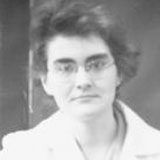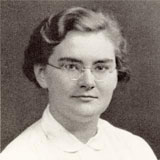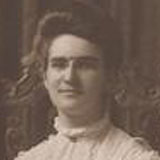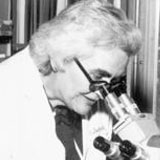Biography: Dr. Helen M. Ranney

Year: 1953
Achievement: Dr. Helen Ranney's landmark research was part of the earliest proof of a link between genetic factors and sickle cell anemia.
Year: 1984
Achievement: Dr. Helen Ranney was the first woman president of the Association of American Physicians.
Year: 1986
Achievement: Dr. Helen Ranney served five years as a Distinguished Physician of the Veterans Administration, the first woman ever to receive that distinction.
Dr. Helen Ranney's landmark research during the 1950s was some of the earliest proof of a link between genetic factors and sickle cell anemia. She went on to become the first woman to chair the department of medicine at the University of California, San Diego, and was the first woman president of the Association of American Physicians from 1984 to 1985.
Helen Ranney was born in 1920 and grew up on a dairy farm in upstate New York. Her father, a farmer with an inventive streak, and her mother, a teacher, instilled in her a "hands-on" approach to life and hoped she would have a professional career. She entered Barnard College as a pre-law student, but switched to pre-medicine because she enjoyed applying science to human life. "I like people and dealing with people...economists, sociologists, and the like study things you can't fix, even if you could find out what was wrong. Medicine attempts to fix what it studies."
After graduating cum laude from Barnard College, she applied to Columbia University's College of Physicians and Surgeons (P&S) in 1941, but was rejected. Taking a job as a laboratory technician at New York's Babies Hospital, she gained skills that later helped her in her research. When she reapplied to P&S during World War II, she was accepted—the school was admitting more women while men were away serving in the military. She received her M.D. in 1947 and continued her association with P&S and Columbia-Presbyterian Medical Center through her training and early professional years. Dr. Ranney was admired for her patient care and teaching as well as for her research, and was known for her intelligence and insight, warmth and wit.
Dr. Ranney is best known for her biochemical discoveries. During her postdoctoral training in hematology (the scientific study of blood) under Dr. Irving London, she devised a way to distinguish the normal molecular structure of human hemoglobin (the iron-rich pigment in red blood cells that carries oxygen from the lungs to other tissues) from an abnormal structure associated with sickle-cell anemia, a disease that predominantly affects African Americans. Compairing hemoglobin healthy people with relatives who had sickle-cell disease, Dr. Ranney was one of the first to identify a genetic factor in the disease. In 1972 she was awarded the Dr. Martin Luther King, Jr., Medical Achievement Award for her work in hemoglobin chemistry.
She continued her work on hemoglobin at the Albert Einstein College of Medicine in New York City, where she was made professor in 1965 and at the State University of New York, Buffalo. In 1973 she accepted the chair of the Department of Medicineat the University of California, San Diego in 1973. The same year she was elected to the prestigious National Academy of Sciences.
In recommending her for chair at the University of California, San Diego, Dean Paul Marks described her as "one of the nation's outstanding investigators of hemoglobinopathies" (diseases or abnormalities of the iron-containing pigment in red blood cells) and "an outstanding clinician and a superb teacher...a person of the highest integrity and quality."
When she left the University of California, San Diego, in 1991, the university established an endowed chair in her name. The Helen M. Ranney Chair in Medicine was the first research chair at the medical school named after a professor, the first endowed chair funded by the faculty, and the first endowed chair at USCD named in honor of a woman professor.
Dr. Ranney served as president of the American Society of Hematology and was the first woman to be president of the Association of American Physicians from 1984 to 1985. After her retirement from the University of California, from 1986 to 1991 she was a Distinguished Physician of the Veterans Administrations, the first woman ever appointed to that position.
Ranney became a board member, advisor, and consultant to the Alliance Pharmaceutical Corporation in San Diego in 1991, where she focused on medical uses of fluorocarbons, especially as carriers for oxygen. She also worked to provide medical care for under-served populations, particularly those living along the U.S.-Mexican border.

Dr. Helen M. Ranney
Dr. Helen M. Ranney
During my career in medicine, I practiced probably what would be mostly called academic medicine. I had a research program in addition to a clinical program. In the clinical program I saw patients who had 'hematologic,' that is, blood, disorders. These would be patients who had diseases of the red blood cells-sickle cell anemia, or thalassemia, some patients who had leukemia or who had bleeding disorders. In my class in medical school there was a class of 120 and there were 5 women. And that was about standard, plus or minus a few- that was about standard for most of the Ivy League schools. I don't think that one was aware of being treated differently than men by any of the faculty. There were clearly some of the students who rather resented the fact that there were women in the class, but you know, one didn't really take that terribly seriously. They were the kind of students one didn't take seriously. I think that probably I was slower to be recognized academically then I would have been, had I been a man... but I didn't really notice it. I never really cared about whether I was an associate professor or not. The only place where I was sure that I probably was discriminated against was at times in the salary scales. At times it was fairly clear to me that men of the similar rank, and if anything, somewhat lesser accomplishment, were making more money. And I was aware that that happened from time to time. On the other hand, I had enough money, so it didn't really matter. I was offered the position in San Diego because they wanted a chair of the department of medicine, and it, again, was a new school. My devotion has been to new things that were getting started. There was a lot to be done, and a lot of new faculty to be recruited, and a lot of building to be done. I think it's important to mentor the young physicians who are interested in research, and who need some time to get the tools, the necessary tools, and to learn how the research is done. And also how grants are obtained, and how grants are administered, and how the American system requires some administrative kind of role model for a person who's entering it for the first time.







